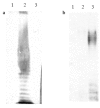Hemolytic uremic syndrome in pediatric intensive care units in são paulo, Brazil
- PMID: 21804902
- PMCID: PMC3143539
- DOI: 10.2174/1874285801105010076
Hemolytic uremic syndrome in pediatric intensive care units in são paulo, Brazil
Abstract
The hemolytic uremic syndrome (HUS) caused by Shiga toxin-producing Escherichia coli (STEC) is one of the most frequent causes of pediatric acute renal failure. The aim of this study was to report the clinic and microbiologic features associated with 13 post-diarrheal HUS cases identified in pediatric intensive care units in the city of São Paulo, Brazil, from January 2001 to August 2005. Epidemiologic, clinic, and laboratorial information, along with fecal and serum samples, were collected for identifying the genetic sequences of Stx and for studying antibodies directed against LPS O26, O111 and O157. STEC was isolated from three patients, and serotypes O26:H11, O157:H7 and O165:H- were identified. In nine patients, high levels of IgM against LPS O111 (n=2) and O157 (n=7) were detected. Dialysis was required in 76.9% of the patients; arterial hypertension was present in 61.5%, neurological complications were observed in 30.7%, and only one patient died. During a 5-year follow-up period, one patient developed chronic kidney disease. The combined use of microbiologic and serologic techniques provided evidence of STEC infection in 92.3% of the HUS cases studied, and the importance of O157 STEC as agents of HUS in São Paulo has not been previously highlighted.
Keywords: E. coli O157; Hemolytic Uremic Syndrome; Shiga toxin; children.; dialysis; diarrhea; pediatric intensive care unit.
Figures




Similar articles
-
Cluster of hemolytic-uremic syndrome caused by Shiga toxin-producing Escherichia coli O26:H11.Pediatr Infect Dis J. 2003 Apr;22(4):349-54. doi: 10.1097/01.inf.0000059338.38673.ae. Pediatr Infect Dis J. 2003. PMID: 12690276
-
Comparative genomic analysis of a Shiga toxin-producing Escherichia coli (STEC) O145:H25 associated with a severe pediatric case of hemolytic uremic syndrome in Davidson County, Tennessee, US.BMC Genomics. 2020 Aug 17;21(1):564. doi: 10.1186/s12864-020-06967-3. BMC Genomics. 2020. PMID: 32807093 Free PMC article.
-
Detection of Shiga toxin-producing Escherichia coli serotypes O26:H11, O103:H2, O111:H8, O145:H28, and O157:H7 in raw-milk cheeses by using multiplex real-time PCR.Appl Environ Microbiol. 2011 Mar;77(6):2035-41. doi: 10.1128/AEM.02089-10. Epub 2011 Jan 14. Appl Environ Microbiol. 2011. PMID: 21239543 Free PMC article.
-
Hemolytic uremic syndrome due to Shiga toxin-producing Escherichia coli infection.Med Mal Infect. 2018 May;48(3):167-174. doi: 10.1016/j.medmal.2017.09.012. Epub 2017 Oct 18. Med Mal Infect. 2018. PMID: 29054297 Review.
-
Extrarenal manifestations of the hemolytic uremic syndrome associated with Shiga toxin-producing Escherichia coli (STEC HUS).Pediatr Nephrol. 2019 Dec;34(12):2495-2507. doi: 10.1007/s00467-018-4105-1. Epub 2018 Nov 1. Pediatr Nephrol. 2019. PMID: 30382336 Review.
Cited by
-
Genomic Epidemiology of Shiga Toxin-Producing Escherichia coli Isolated from the Livestock-Food-Human Interface in South America.Animals (Basel). 2021 Jun 22;11(7):1845. doi: 10.3390/ani11071845. Animals (Basel). 2021. PMID: 34206206 Free PMC article.
-
Hemolytic-Uremic Syndrome in Uberlândia, MG, Brazil.ISRN Pediatr. 2011;2011:651749. doi: 10.5402/2011/651749. Epub 2011 Dec 1. ISRN Pediatr. 2011. PMID: 22389782 Free PMC article.
-
Humoral immune response to Shiga Toxin 2 (Stx2) among Brazilian urban children with hemolytic uremic syndrome and healthy controls.BMC Infect Dis. 2014 Jun 11;14:320. doi: 10.1186/1471-2334-14-320. BMC Infect Dis. 2014. PMID: 24919599 Free PMC article.
-
Global population structure, genomic diversity and carbohydrate fermentation characteristics of clonal complex 119 (CC119), an understudied Shiga toxin-producing E. coli (STEC) lineage including O165:H25 and O172:H25.Microb Genom. 2023 Mar;9(3):mgen000959. doi: 10.1099/mgen.0.000959. Microb Genom. 2023. PMID: 36951916 Free PMC article.
-
Recent advances in understanding enteric pathogenic Escherichia coli.Clin Microbiol Rev. 2013 Oct;26(4):822-80. doi: 10.1128/CMR.00022-13. Clin Microbiol Rev. 2013. PMID: 24092857 Free PMC article. Review.
References
-
- Karmali MA, Petric M, Lim C, Fleming PC, Steele BT. Escherichia coli cytotoxin, hemolytic-uremic syndrome, and haemorrhagic colitis. Lancet. 1983;ii:1299–300. - PubMed
-
- Kaper JB, Nataro JP, Mobley HLT. Pathogenic Escherichia coli. Nat Rev. 2004;2:123–40. - PubMed
-
- Caprioli A, Morabito S, Brugere H, Oswald E. Enterohemorrhagic Escherichia coli: emerging issues on virulence and modes of transmission. Vet Res. 2005;36:289–311. - PubMed
LinkOut - more resources
Full Text Sources
